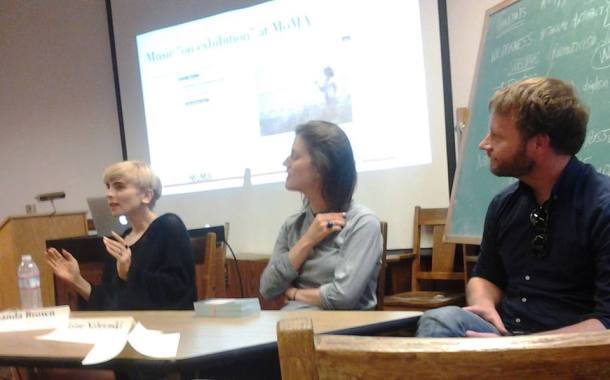On the Record with Amanda Brown, Jaime Nabrynski, and Dawson Ludwig.
It was Thursday, September 12, and the Archaeological Research Facility, one of the older buildings on Cal’s campus, welcomed an eager and uncertain audience for a unique, two-hour panel discussion on contemporary music.
After a rough week of classes, the three respectable industry personnel who decked the panel—label CEO Amanda Brown, Noise Pop Director Dawson Ludwig, and Jaime Nabrynski of Zeitgeist Management—were sure to lighten the mood with their engaging views.
And such they did. Excellently.
Attended by a ragtag collection of casual listeners, aspiring musicians, teachers, and a table full of organic snacks, the meeting was delightfully intimate. The questions were well formed and the panelists, like music label authority Amanda Brown, were brutally honest in return.
Unauthorized sampling is what most of the artists on her label do, Brown, co-founder of Not Not Fun and 100% Silk, boldly admitted to listeners.
Brown operates both independent labels out of her apartment with her husband, Britt. Brown describes beat-digging, or scouting for suitable soundbytes, as an “art of collage.”
Like arthouse films made of found footage, most of Brown’s artists craft their tracks by piecing together rare collectibles from those decades of forgotten music; lesser known samples are the digger’s treasure trove.
But sampling, according to the evening’s discussion, is hardly the entertainment industry’s primary concern these days—that honor goes to artist revenue and royalties as they relate to the artist’s ability to make a living while the labels and agencies take their share.
Collectively, the panel agreed that music has evolved to give artists the short end of the stick. Discussion member Nabrynski would rather music be everywhere. And fellow speaker Ludwig called streaming music a commodity.
But they also feared artists may compensate for their income shift by allocating price inflation to a channel they can count on: ticket prices for live performances.
Despite the concern, live music is certainly where the answer for artist compensation lies. It is becoming increasingly common for a musician or group to tour year-round and record new tracks in makeshift hotel-suite-studios or in the back of an RV while they hit the road. Because it’s the only way to earn some cash from the art.
Nabrynski was frank. “There’s no money in this industry,” she said.
Artists are feeling the hit, making themselves more available to promote their music. They constantly Google themselves, keeping tabs on their status, and are anxious for reviews and publicity.
They are proficient social media hounds, making themselves available on a multitude of outlets.
Nabrynski also pointed out fanbase culture, a respectable marketing technique and an unfortunate byproduct of American branding.
Brown elaborated, comparing music festivals in the United States with those in Europe. “They’re all about eclecticism there,” she said. Whereas on this side of the pond, Noise Pop Fest will consistently attract a larger audience and more revenue on its first day, which is reserved for hip-hop, dance, and electronic genres. Performers are grouped by style and listeners expect a uniform presentation.
The discussion landed on its final question, which involved the classification of music as a high art.
It’s unfortunate, the room conceded, that pop music is possibly the last art to determine where it stands on the high art spectrum. That is, who would curate a “music museum”? Would Beyoncé stand respectably next to The Beatles?
As inconclusive as the discussion was, the questions raised and the dissenting responses paint a concerning, hopeful, and accurate representation of the future of music.
Follow the link below to hear the entire discussion.
https://soundcloud.com/resounducberkeley/on-the-record-audio
Article by Joanna Jiang



[…] less-than-friendly domain, especially for young artists and indie bands. The future of music seems uncertain. But many musical folks are still hopeful and even grateful about their profession–at least […]